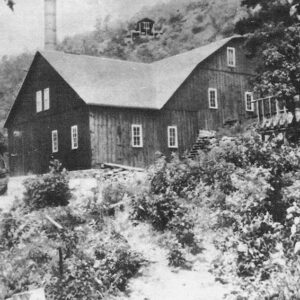calsfoundation@cals.org
Rush (Marion County)
Marion County lays claim to the only ghost town between the Mississippi River and the Rocky Mountains. The remains of the prosperous zinc-mining town of Rush attained this status almost fifty years ago. A true ghost town exhibits the physical existence of structures, including buildings, and a zero population.
During the early 1880s, prospectors came to the Rush area in search of lost silver mines from Indian legends and found shiny metallic flakes believed to be silver concentrated in the rocks. Within a short time, news of the discovery spread like wildfire throughout the Mid-South, making eyes from far away turn to the hills of Arkansas, focusing on the mineral wealth near the Buffalo and White Rivers.
A rock smelter was constructed in 1886 along Rush Creek to extract the metallic substance believed to be silver. To their dismay, in a test run of the smelter in January 1887, green zinc oxide fumes were emitted in a spectacular display, with the predicted silver failing to collect in the sand molds. Shortly thereafter, zinc mining began at the Morning Star Mine.
There were a number of reasons why the rush to Rush attained momentum. A few prospectors coming to the area were striving to get as far from the law as possible. Professional men and merchants focused upon an opportunity to provide the needs of a growing community, and land speculators were looking for quick fortune. Most of the settlers coming to Rush were farmers, general laborers, unskilled mechanics, miners, and former soldiers from Tennessee, Kentucky, Alabama, Georgia, Missouri, and the Carolinas, all looking for ways to get rich quick. With the continuous migration, the mining camp soon reached a population of almost 5,000. In 1916, documents were filed incorporating Rush into a city. Rush was recognized as the most prosperous city per capita in Arkansas. In those early days, it was common to find four or five tents pitched in the morning, and then by afternoon additional tents had been added and were stringing in every direction—whereas others made shelters from rocks or packing boxes to protect themselves from the elements of nature.
A large zinc nugget weighing 13,000 pounds from the Morning Star mine received blue ribbons at the 1892 Chicago World Fair, and another large specimen won a blue ribbon at the St. Louis World Fair in 1904.
With the end of World War I, the demand and price for zinc rapidly declined, and the population of Rush began to erode. With a domino affect, the mines ceased to operate, and the closing of the post office in the mid-1950s caused Rush’s loss of identity. Gradually, the remaining inhabitants continued to drift away, and Rush was recognized officially as a ghost town in 1972 when it was included in lands acquired in the creation of the Buffalo River National Park System. The Rush Historic District was listed on the National Register of Historic Places on February 27, 1987.
For additional information:
Adams, George I. Zinc and Lead Deposits of Northern, Arkansas. United States Geological Survey, Professional Paper 24. Washington DC: Government Printing Office, 1904.
Blevins, Bill Dwayne. Rush, A Ghost Town. Pangburn, AR: Tumbling Shoals Publishing Company, 2002.
Branner, John C. Annual Report of the Geological Survey of Arkansas for 1892. Vol. 5, The Zinc and Lead Region of North Arkansas. Little Rock: Office of the Geological Survey of Arkansas, 1906.
Jenkins, Cary. “Take It Slowly in Rush.” Arkansas Democrat-Gazette, November 29, 2020, pp. 1E, 4E.
McKnight, Edwin T. Zinc and Lead Deposits of Northern Arkansas. United States Geological Survey, Bulletin 853. Washington DC: Government Printing Office, 1935.
Ross, Jane Ellen. “Zinc! By Thunder!: A History of the Rush Creek Mining District, Marion County, Arkansas, 1887–1920.” MA thesis, University of Arkansas at Little Rock, 2009.
“Rush Historic District.” National Register of Historic Places registration form. On file at Arkansas Historic Preservation Program, Little Rock, Arkansas.
Bill Dwayne Blevins
Mountain Home, Arkansas
 Marion County Map
Marion County Map  Morning Star Mine
Morning Star Mine  Morning Star Zinc Mine
Morning Star Zinc Mine  Old Courthouse in Rush
Old Courthouse in Rush  Old Philadelphia Mine
Old Philadelphia Mine  Rush Ghost Town
Rush Ghost Town  Rush Mill
Rush Mill  Rush Miners
Rush Miners  Rush Store
Rush Store  Rush Street Scene
Rush Street Scene  Silver Hollow Mine
Silver Hollow Mine  Zinc Furnace
Zinc Furnace 




Comments
No comments on this entry yet.